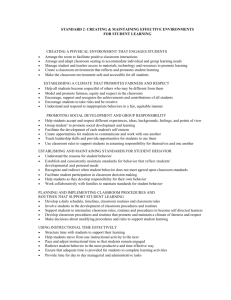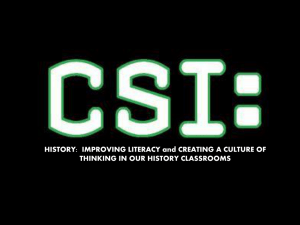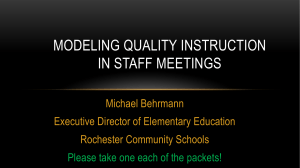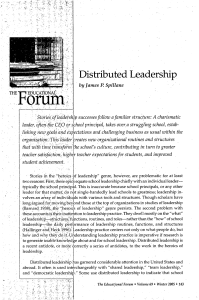PowerPoint Slides
advertisement
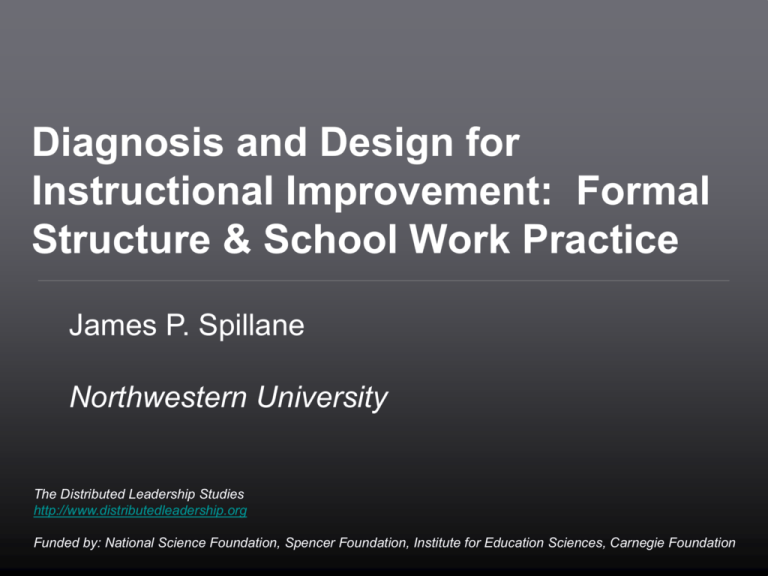
Diagnosis and Design for Instructional Improvement: Formal Structure & School Work Practice James P. Spillane Northwestern University The Distributed Leadership Studies http://www.distributedleadership.org Funded by: National Science Foundation, Spencer Foundation, Institute for Education Sciences, Carnegie Foundation Anchoring Instructional Improvement Work Improving Students’ Opportunities To Learn Classroom Teaching What gets taught? How is it taught? School Practice Organization & System Infrastructure It’s All About Practice • Instructional improvement depends on work practice in schools • Practice is fundamentally social and distributed … • Generated in the interactions among school staff • The situation (social structure) enables and constrains interactions • Situation is both constitutive of, and constituted in, practice • Understanding relations between (Infra)structure and interactions is critical for instructional improvement efforts • A Diagnostic and Design Mindset is essential to instructional improvement Conceptualizing Teaching Teacher Students Materials (Cohen & Ball, 1998; Delpit, 1996; Hawkins, 1977) Overview of Talk a) Diagnosis and Design: From a Distributed Perspective b) Diagnosis and Design: The Case of Organizational Routines c) Designing for Practice: How Infrastructure Matters What’s this got to do with Lesson Study? • Lesson study is about (transforming) how teachers practice inside and outside the classroom. • Lesson Study is a case of an organizational (or system) routine. • ‘Going to scale’ with lesson study is fundamentally about understanding the dynamics between social (infra)structure and social interactions … the essence of practice. Diagnosis and Design from a Distributed Perspective “We have one hunter and one gatherer … everyone else is a consultant” Diagnosis and Design Diagnosis = identify nature or cause of something Design = shaping things/objects/positions to purposes A Distributed Perspective • A diagnostic framework that draws attention to particular dimensions of work practice in schools • A design framework for guiding leadership and management improvement efforts. Practice: From a Distributed Perspective Leaders Administrators, Specialists, Teachers School Work Practice Situations Tools, Routines, Structures Followers Teachers, Administrators, Specialists Formal positions, organizational routines as represented in formal documents and accounts Designed vs. Lived Organization Organization as experienced in day-to-day life of organizational members Diagnosis and Design: The Case of Organizational Routines Diagnosis and Design Work Organizational Routines & Practice • Adams School: Breakfast Club, Grade level meetings, Teacher Talk, Teacher Leaders, Five-Week Assessment, Literacy Committee, and Mathematics Committee • Baxter School: Cycle Meetings, Leadership Team Meetings, Literacy Committee, Math/Science Committee • Kosten School: Report Card Review, Grade Book Review, Lesson Plan Review, Faculty Meetings, Grade Level Meetings • Kelly School: Skill Chart Review, Professional Development The Case of Organizational Routines • Organizational Routines: “repetitive, recognizable patterns of interdependent actions carried out by multiple actors” (Feldman & Pentland, 2003) • Ostensive Aspect: ideal form – general idea or script of the routine • Performative Aspect: routine in practice in particular places, at particular times • Improving Practice in the interaction of the ostensive and performative aspect of organizational routines. • Concerns about the organizational routine construct – rigid, mundane, mindless, explicitly stored (Cohen, 2007) Organizational Routines Advantages Allow efficient coordinated action Provide source of stability Reduce conflict about how to do work Disadvantages Result in inappropriate responses Inertia, mindlessness, and de-motivation Organizational Routines at Adams School Routine Functions Tools People Five Week Assessment -Formative evaluation -Teacher Accountability -Monitor Instruction -Teacher Development -Standardized Tests -Standards -Student Assessments -Language Arts Breakfast Club -Teacher Development -Build Professional -Research Articles -Teachers -Language Arts Community School Improvement Planning (SIP) -Identify Instructional Priorities & Resources Coordinator -Assistant Principal -Principal -Teachers Coordinator -Principal -Previous Year SIP -District Guidelines -Test Score Data -Principal -Administration -Teachers (approved LSC) Classroom Observations -Teacher Development -Monitor Instruction -Accountability -School Protocol, -District Protocol -Principal -Assistant Principal Real Men Read -Student Motivation and -Books -Language Arts Co-ord. -Assistant Principal -Principal -Community Members Support Five Week Assessment: Ostensive Aspect Step 1. Literacy Committee Identifies Needs & New Directions Step 8. Literacy Coordinator Shares Scores with Administrators and Teachers & Plan Future Assessments Step 7. Literacy Coordinator and Assistant Compile and Analyze Scores Step 6. Literacy Coordinator and Assistant Score Assessments Step 2. Literacy Coordinator Plans Five Week Assessment Schedule Step 3. Literacy Coordinator Develops Assessments Step 4. Literacy Coordinator and Assistant Copy and Distribute Assessments to Teachers Step 5. Teachers Administer & Return Assessments to Literacy Coordinator The Five Week Assessment “We were just kind of casually saying that for the majority of teachers they all work very hard, but some of them get very low results when it comes to these achievement tests … So this [Five Week Assessment] was a way to find out ‘Are they learning?’” (Literacy coordinator, 5/15/00) “The Five Week Assessment enabled teachers to see assessment as a tool for letting them know what they need to work on in the classroom. That was the goal.” (Literacy coordinator, 10/23/00) “The [standardized] tests … didn’t give us much information about what we could do to improve our scores because we received the results well after we could do anything about it. We thought that a more frequent assessment … would tell us where the children were” (Principal Williams) System and Organizational Infrastructure Designing for Practice: How Infrastructure Matters Changing Infrastructure, Changing Interactions “Everybody did absolutely their own thing as far as literacy. Some people used the Basal series . . . we had different Basal series going in the building. A lot of people were going to a literature-based instruction. Nobody ever talked to each other. It was just—everybody went into their own room, closed the door and did their own thing. So we’ve tried to develop some common vocabulary and common ways of doing things.” Teacher Interview “You close your door. You do what you want. You don’t know what everybody else is doing and it’s fine. Nobody is interested. Nobody’s checking on you or even interested in what you are doing . . . but it changed since then. We work much closer together and I was a very quiet person. . . . Until I was probably elected to . . . chair cycle. First of all, we probably were forced to do some exchange of ideas in—when it first started. Then people found it’s very helpful and nobody keeping anything as a secret so we share freely. And it helps.” Organizational Routines: Performative Aspect Ms. Sally then switched the topic of discussion to a uniformed spelling program for the grade. She raised the point that it was important for the grade "to be following a sequence for instruction for phonics." Ms. Jill also wants to bring in one of her own favorite books into the curriculum which she claims has a "consistent format which is the most important because the students are missing a range of words. … Ms. Dalia then raised the point that she would be concerned that the grade would not be following the standards of the Illinois State in reference to the [Jill’s] book. [Grade Level Meeting at Baxter, 10/28/99] Ms. Jones [mathematics teacher leader] remarks, “I don’t too much worry about this one [kind of] question. But now if it’s four or five questions [about the same content on the state test] I target in on that and I make sure my kids know that…” [Annual Kick-off Faculty Meeting at Adams, 8/31/01] Organizational Routines at Local Proxies for Policy: The Five Week Assessment First I would like to say congratulations to grade levels—all grade levels made some improvements from the Five Week Assessments to the Ten Week Assessment which is a reflection of your time and commitment to getting students to learn … Third through fifth [grade students need to work on their] abilities to write descriptive words … Probably lacking in vocabulary, ability to pick out details from the story. [Grade Level Meeting] They [students] did a good job identifying the problem and solution of the story … Which leads me to middle school. Problem and solution didn’t always match … this is truly a concern … Little trouble determining the important information in the story. Questions most missed were vocabulary questions … I have a packet with lessons on teaching vocabulary. I’ll pass it around and if you want me to make you a copy, put your name on the green sticky note [Literacy Committee Meeting, Field Notes, 11/06/00] Organizational Routines Performative Aspect Adams Baxter Kosten Kelly Policy 72% 67% 80% 73% Technical Core 100 88 93 82 Technical Core & Policy 72 67 73 73 Language Arts 62 62 24 46 Math 36 10 17 36 Science 17 10 7 9 A Study of Elementary School Mathematics Study Design Survey Response Rate 14 elementary schools In Pleasantville, Nebraska. 2010: 311 staff, 89% response rate, ranging from 82% to 100%. School Staff surveys administered in Spring 2010, 2011, 2012, (& 2013). 2011: 337 staff, 95% response rate, ranging from 93% to 100%. Interviews with purposeful subsample in five schools in 2011 and 2012. 2012: 375 staff , 94% response rate, ranging from 83% to 100%. Research Question: How do infrastructure redesign efforts shape staff interactions? ? District Infrastructure Design for Teacher Leadership • Infrastructure for mathematics instruction • Resource and material adoption (Investigations) • State standards alignment • Unit assessment development • Infrastructure (re)design for teacher leadership • District-wide and school specific organizational routines (e.g., arrays, toolbox, PLCs). • Math Coaches in some schools • Professional development for select math teacher leaders Social Network Instrument Screen Shot from SSQ – Math Advice Questions Page 1 Why Focus on Advice and Information Interactions? • On-the-job interactions associated with the transfer of advice and information – essential to knowledge development: • Socialization: Tacit Knowledge—Tacit Knowledge • Externalization: Tacit Knowledge – Explicit Knowledge • Combination: Explicit Knowledge – Explicit Knowledge • Internalization: Explicit Knowledge – Tacit Knowledge Blau, 1957; Bryk & Schneider, 2002; Choo, 1998; Coburn, 2001; Daly & Finnigan, 2010; Elmore, 1996; Eraut & Hirsh, 2007; Frank, Zhao, & Borman, 2004; Hill, 2004; Little, 2002; Smylie, 1995; Spillane, 2004 Advice and Information Interactions A C B Fundamental Math Math Coach Fundamental Math Woodpecker Math Network 2011-2012 Math Coach (Emily) Facilitates Staff Interactions 2009-10 2010-11 2011-12 Formal Position Promotes Advice Seeking “[Emily] really wasn’t our facilitator [last year], though she was my co-worker, just a third grade teacher. I knew she had a wealth of knowledge, I just wasn’t in [her classroom] when she was teaching math. But, now that she’s moved into this math facilitator position, that’s different…She’s been trained in it. And, she’s gone to school for it and she’s a great coach. She knows a lot about math and I trust her that she has a lot of, a wealth of knowledge… She’s the go-to person.” Angie, Special Education Professional Development Case (John) 2009-10 2010-11 2011-12 Training Also Serves as a Marker of Expertise Karen (1st grade) “Because he’s a second grade teacher….He’s kind of become the math person to see because he’s taken this extra training that nobody else in the building has done, and I know that he’s interested in math so, he’s just one that I’ve gone to that I know focuses very heavily on, I like his beliefs and the way that he has his room set up and the way that he carries himself.” Infrastructure Redesign Promoted Advice and Information Seeking in Mathematics Average In-Degree for Teachers Leaders and Other Teachers, Pleasantville School District 2009-10 2010-11 2011-12 Toolbox Members (6) 1.60 2.80 2.67 Fundamental Math Participants (9) 4.33 6.00* 6.00 Math Coaches (3) 6.33 16.33** 18.00 Other Teachers (256) 1.54 1.60 1.36 *p<.05; **p<.01 Infrastructure Redesign Promoted Brokering in Mathematics Average Betweenness for Teachers Leaders and Other Teachers, Pleasantville School District 2009-10 2010-11 2011-12 5.00 75.80* 48.86 Fundamental Math Participants (9) 32.44 144.33* 115.42 Math Coaches (3) 38.67 248.67** 222.97 Other Teachers (256) 10.85 24.81* 11.90 Toolbox Members (6) *p<.05; **p<.01 Formal Organizational Structure & Advice & Information Interactions • Teachers more likely to seek advice from others of same gender and race. • Prior tie strongly associated with having a current tie. • Formal leaders more likely to provide advice or information. • Teachers in the same grade were more likely to receive or provide advice or information • Teachers more likely to seek advice about a subject from teachers who reported more PD in that subject. Spillane, J. P., Kim, C. M., & Frank, K. A. (2012). Instructional advice and information seeking behavior in elementary schools: Exploring tie formation as a building block in social capital development. American Educational Research Journal. Pleasantville District Math Network Pleasantville District ELA Network Infrastructure • Anchoring in and Alignment with Instruction • Cognitive adequacy • Consistency • Communicability, Corruptibility, and Correctability • Authority and Power Conclusion Lesson Study: Ostensive Aspect? • Teachers design, collaboratively, detailed lesson plan • Teacher teach lesson in a real classroom as other others observe • Teachers together discuss their observations of the lesson and redesign lesson • Another teacher teaches redesigned lesson and group critique • Lesson should be both relevant and useful for teachers when examining their practice. Asking Design Questions What is the theory of action behind the routine/tool? What arguments explain and evaluate the routine/tool? Why should it work? Why might it not work? What are the advantages of this routine? What are the disadvantages of this routine? How does it connect with classroom teaching and learning? ‘Kernel’ Organizational Routines • Propagate and seed new forms of school practice • Key characteristics: • focused on teaching and student learning • anchored in both intended curriculum and enacted curriculum • build common understanding among school staff • build trust among school staff • enable mutual access to information among staff • build routes for new information to enter the school • facilitate tailoring of the routine by school staff to local circumstances (Resnick, L. B., Spillane, J. P., Goldman, P., & Rangel, E., 2 Conclusion • School and system infrastructure design and redesign essential to improving work practice in schools. • The essence of instructional change: • Understanding relations between infrastructure and everyday interactions. • Understanding how components of infrastructure travel and often get lost in translation. • Adopt a Diagnosis and Design Mindset Publications and Presentations available online: www.distributedleadership.org • Spillane, J. P., Parise, L. M., & Sherer, J. Z. (2011). Organizational routines as coupling mechanisms: policy, school administration, and the technical core. American Educational Research Journal, 48(3), 586620. • Spillane, J. P., & Anderson, L. M. (under review). Policy, practice, and professionalism: Negotiating policy meanings in practice in a shifting institutional environment. Educational Evaluation & Policy Analysis. • Sherer, J. Z., & Spillane, J. P. (2010). Constancy and change in school work practice: Exploring the role of organizational routines. Teachers College Record, 113(3). • Spillane, J. P., Kim, C. M., & Frank, K. A. (2012). Instructional advice and information seeking behavior in elementary schools: Exploring tie formation as a building block in social capital development. American Educational Research Journal, 49(6), 1112-1145. • Spillane, J. P., & Healey, K. (2010). Conceptualizing school leadership and management from a distributed perspective. The Elementary School Journal, 111(2). • Spillane, J. P., Healey, K., & Kim, C. M. (2010). Leading and managing instruction: Using social network analysis to explore formal and informal aspects of the elementary school organization. In A. J. Daly (Ed.), Social network theory and educational change (pp. 129-156). Cambridge, MA: Harvard Education Press. MORE AT: http://www.distributedleadership.org
